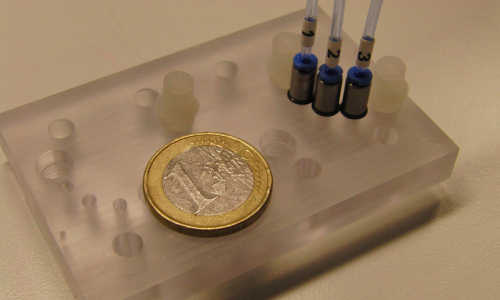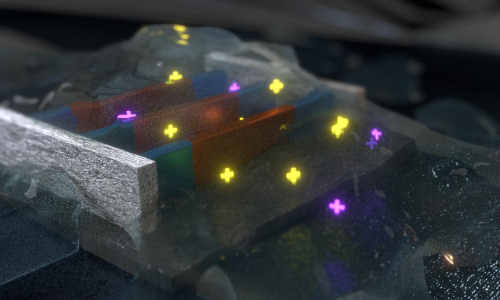In medical research, animal-based experiments have thus far been a necessary evil. Fraunhofer researchers have developed a highly promising alternative, however: They are developing a mini-organism inside a chip. This way, complex metabolic processes within the human body can be analyzed realistically.
No one wishes to dispense with the blessings of modern medicine, which took away the dread of many diseases. The flipside of the coin: To ensure that effective and safe medications are available, experiments on animals in research laboratories are indispensable. Throughout the world, researchers are working on alternatives to animal experiments. Yet it is difficult to find a substitute. Because in order to understand the effect of a substance, it is not enough to test the substance on isolated tissue samples or cells. “Most medications work systemically – that is to say, on the organism as a whole. In doing so, toxic substances frequently emerge through metabolic processes, which in turn damage only certain organs,” explains Dr. Frank Sonntag of the Fraunhofer Institute for Material and Beam Technology IWS.
Using the compact multi-organ chip (comparable in size to a one-euro piece), and those of three separate microcircuits, researchers can study the regeneration of certain kidney cells. Photo Credit:Fraunhofer IWS
Chip simulates human circulatory system
Researchers at the Dresden-based institute, working jointly with the Institute for Biotechnology at the Technical University (TU) of Berlin, engineered a new kind of solution that could render the use of animal-based experiments superfluous in medical research: a multi-organ chip that faithfully replicates complex metabolic processes in the human body with startling accuracy. “Our system is a mini-organism on a 1:100,000 scale to the human being,” says Sonntag. Human cells from various organs can be applied to several different positions within the chip. The researchers obtained the cells from blood donations that were made available for research purposes. These “mini-organs” are connected to each other through tiny canals. This way we simulate human blood circulation,” Sonntag explains. Working much like the human heart, a micro-pump continuously transports liquid cell culture medium through infinitesimal micro-channels. The IWS researchers can modify the exact configuration of the chip, i.e. the number of mini-organs and the connection to the micro-channels, specifically to different sets of questions and different applications. With the chip, it is possible to test both the active ingredients in new medications, and also study cosmetics for their skin tolerability.
The concept of combining various cell samples with fluid channels has been around for a long while. This new system, however, has two distinct advantages over previous approaches: Thanks to the expertise of the engineers at IWS, the microfluidic system is extremely miniaturized. The pump is capable of channeling the tiniest flow rates of less than 0.5 microliters (µl/s) per second through the channels. This means the relationship between cell sample and liquid media is authentic,” Sonntag explains. If this ratio is incorrect, then that will lead to imprecise results. Secondly, the microfluidic system ensures there is a constant flow of liquid cell culture medium; like human blood, the medium flows continuously through the entire circuit on the chip. That is important, since some types of calls can only present euthentic “body-like” morphology if they are stimulated by a current or flow.
In order to test the effect of a substance, the scientists initially load various cell samples onto the chip. Then the active ingredient to be tested is added via the medium for the cell sample of that organ at which the substance would be introduced into the blood stream in the real human body. They include the cells of the intestinal lining, for instance. The same metabolic responses are then processed on the chip just like in the human organism. “We use cell samples from various sexes and ethnicities. We can set variations in body size and weight as desired on a scale of 1:100,000,” Sonntag says. The scientists can see exactly which metabolic products form within specific cell samples, and whether and which effects they have on other cells. The results are ultimately even more predictive than those of animal-based experiments. Because the effects on the body of a mouse or a rat cannot be applied to human beings at a 1:1 ratio.
For some companies, such as those in the cosmetics industry, the artificial organism is already in use. In addition to research on active ingredients, there is also another potential application. “We know today that certain kidney cells, the endothelial cells, play a key role in almost every kidney disease. With the in vitro tests to date, there was always the problem that the endothelial cells worked only under current. Here, our multi-organ chip could offer a test environment that would allow you to observe how cells regenerate following an injury,” says Sonntag.
As alternatives to animal testing, the artificial mini-organism was recently awarded the animal safety research prize in 2014.
Story Source:
The above story is based on materials provided by Fraunhofer-Gesellschaft.





